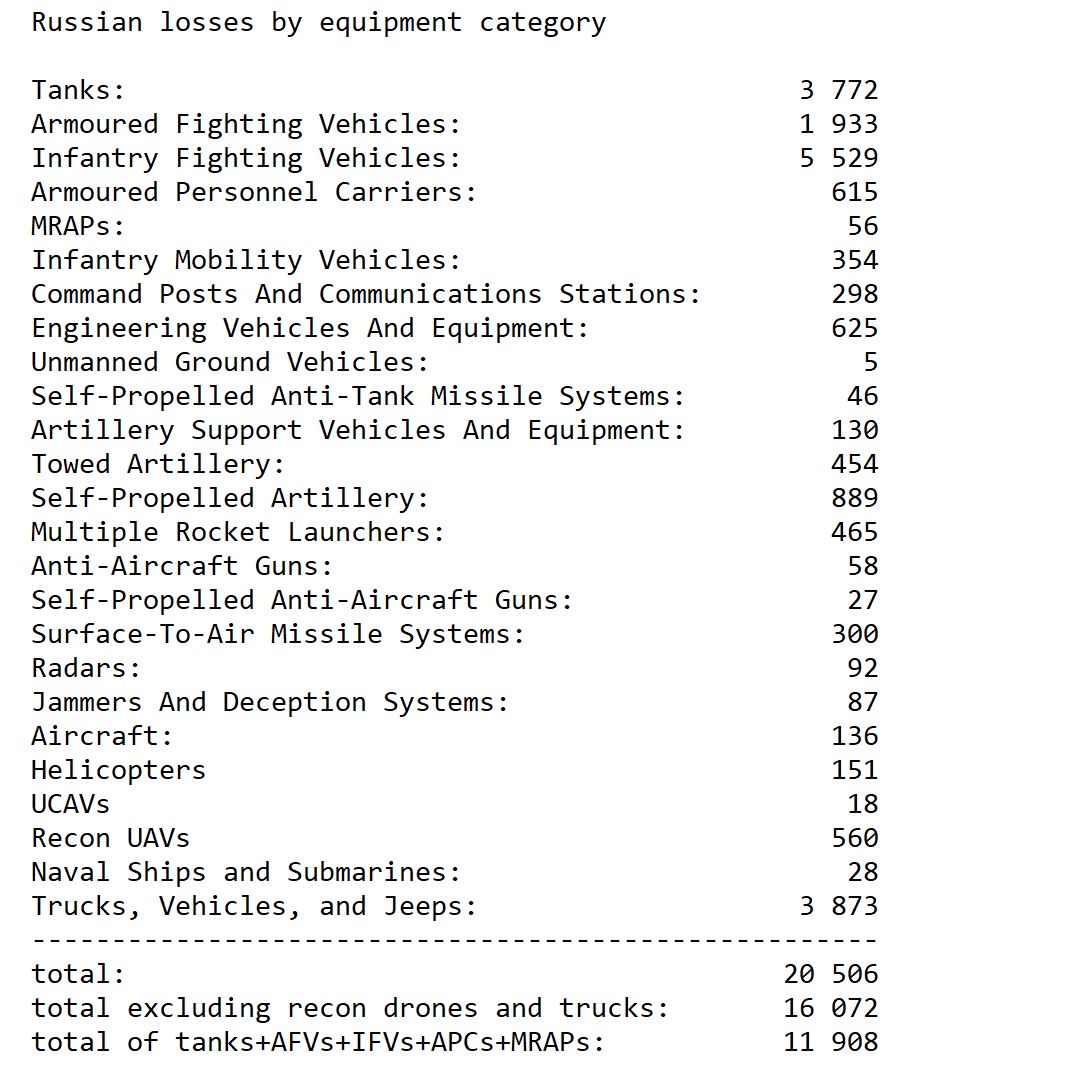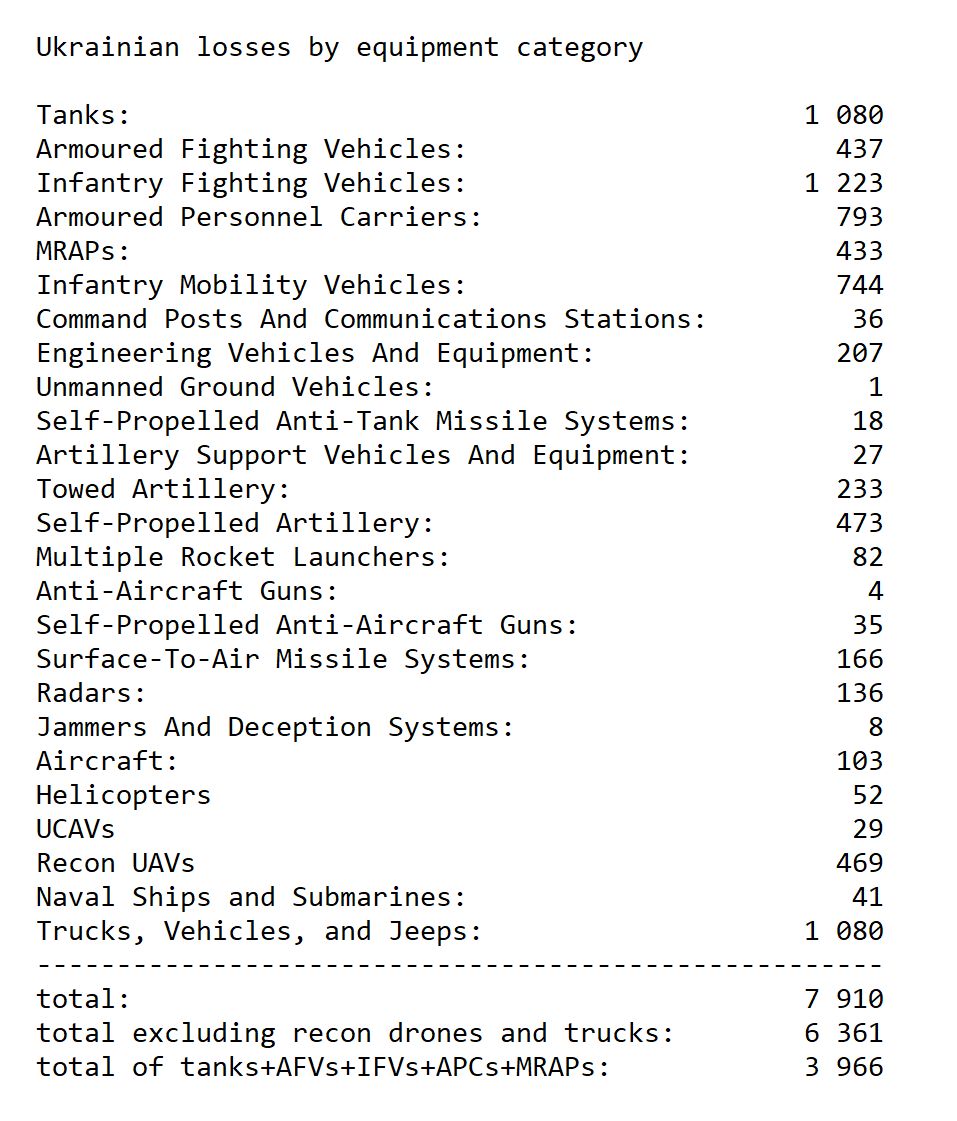#UkraineWar: Overview of Russian equipment losses added on 08/08/2022
Full list: oryxspioenkop.com/2022/02/attack…
Full list: oryxspioenkop.com/2022/02/attack…

#UkraineWar: Overview of Russian equipment losses added on 09/08/2022
Full list: oryxspioenkop.com/2022/02/attack…
Full list: oryxspioenkop.com/2022/02/attack…
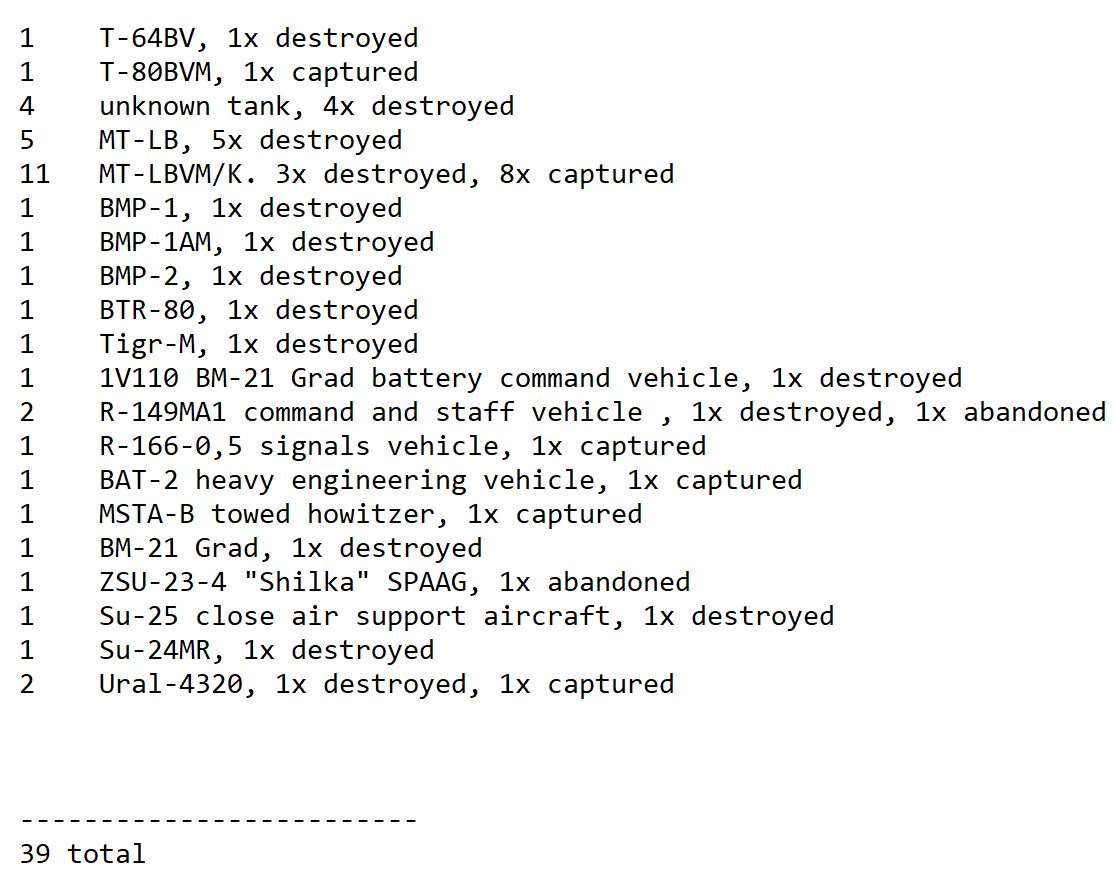
#UkraineWar: Overview of Russian equipment losses added on 10/08/2022
Full list: oryxspioenkop.com/2022/02/attack…
Full list: oryxspioenkop.com/2022/02/attack…

#UkraineWar: Overview of Russian equipment losses added on 11/08/2022
Full list: oryxspioenkop.com/2022/02/attack…
Full list: oryxspioenkop.com/2022/02/attack…

#UkraineWar: Overview of Russian equipment losses added on 12/08/2022
Full list: oryxspioenkop.com/2022/02/attack…
Full list: oryxspioenkop.com/2022/02/attack…

#UkraineWar: Overview of Russian equipment losses added on 13/08/2022
Full list: oryxspioenkop.com/2022/02/attack…
Full list: oryxspioenkop.com/2022/02/attack…

#UkraineWar: Overview of Russian equipment losses added on 14/08/2022
Full list: oryxspioenkop.com/2022/02/attack…
Full list: oryxspioenkop.com/2022/02/attack…

#UkraineWar: Overview of Russian equipment losses added on 15/08/2022
Full list: oryxspioenkop.com/2022/02/attack…
Full list: oryxspioenkop.com/2022/02/attack…

#UkraineWar: Overview of Russian equipment losses added on 16/08/2022
Full list: oryxspioenkop.com/2022/02/attack…
Full list: oryxspioenkop.com/2022/02/attack…

#UkraineWar: Overview of Russian equipment losses added on 17/08/2022
Full list: oryxspioenkop.com/2022/02/attack…
Full list: oryxspioenkop.com/2022/02/attack…

#UkraineWar: Overview of Russian equipment losses added on 18/08/2022
Full list: oryxspioenkop.com/2022/02/attack…
Full list: oryxspioenkop.com/2022/02/attack…

#UkraineWar: Overview of Russian equipment losses added on 19/08/2022
Full list: oryxspioenkop.com/2022/02/attack…
Full list: oryxspioenkop.com/2022/02/attack…

#UkraineWar: Overview of Russian equipment losses added on 20/08/2022
Full list: oryxspioenkop.com/2022/02/attack…
Full list: oryxspioenkop.com/2022/02/attack…

#UkraineWar: Overview of Russian equipment losses added on 22/08/2022
Plus a ton of changes and new losses thanks to @naalsio26 (net changes to the list based on his file are in the 2nd image)
Full list: oryxspioenkop.com/2022/02/attack…

Plus a ton of changes and new losses thanks to @naalsio26 (net changes to the list based on his file are in the 2nd image)
Full list: oryxspioenkop.com/2022/02/attack…


#UkraineWar: Overview of Russian equipment losses added on 23/08/2022
Full list: oryxspioenkop.com/2022/02/attack…
Full list: oryxspioenkop.com/2022/02/attack…

#UkraineWar: Overview of Russian equipment losses added on 24/08/2022
Full list: oryxspioenkop.com/2022/02/attack…
Full list: oryxspioenkop.com/2022/02/attack…

#UkraineWar: Overview of Russian equipment losses added on 25/08/2022
Full list: oryxspioenkop.com/2022/02/attack…
Full list: oryxspioenkop.com/2022/02/attack…

#UkraineWar: Overview of Russian equipment losses added on 27/08/2022
Full list: oryxspioenkop.com/2022/02/attack…
Full list: oryxspioenkop.com/2022/02/attack…

#UkraineWar: Overview of Russian equipment losses added on 28/08/2022
Full list: oryxspioenkop.com/2022/02/attack…
Full list: oryxspioenkop.com/2022/02/attack…

#UkraineWar: Overview of Russian equipment losses added on 30/08/2022
Full list: oryxspioenkop.com/2022/02/attack…
Full list: oryxspioenkop.com/2022/02/attack…

#UkraineWar: Overview of Russian equipment losses added on 31/08/2022
Full list: oryxspioenkop.com/2022/02/attack…
Full list: oryxspioenkop.com/2022/02/attack…

#UkraineWar: Overview of Russian equipment losses added on 01/09/2022
Full list: oryxspioenkop.com/2022/02/attack…
Full list: oryxspioenkop.com/2022/02/attack…

#UkraineWar: Overview of Russian equipment losses added on 02/09/2022
Full list: oryxspioenkop.com/2022/02/attack…
Full list: oryxspioenkop.com/2022/02/attack…

#UkraineWar: Overview of Russian equipment losses added on 03/09/2022
Full list: oryxspioenkop.com/2022/02/attack…
Full list: oryxspioenkop.com/2022/02/attack…

#UkraineWar: Overview of Russian equipment losses added on 04/09/2022
Full list: oryxspioenkop.com/2022/02/attack…
Full list: oryxspioenkop.com/2022/02/attack…

#UkraineWar: Overview of Russian equipment losses added on 05/09/2022
Full list: oryxspioenkop.com/2022/02/attack…
Full list: oryxspioenkop.com/2022/02/attack…

#UkraineWar: Overview of Russian equipment losses added on 07/09/2022
This time the list is so long that I had to split it :)
Full list: oryxspioenkop.com/2022/02/attack…

This time the list is so long that I had to split it :)
Full list: oryxspioenkop.com/2022/02/attack…


#UkraineWar: Overview of Russian equipment losses added on 08/09/2022
Full list: oryxspioenkop.com/2022/02/attack…
Full list: oryxspioenkop.com/2022/02/attack…

#UkraineWar: Overview of Russian equipment losses added on 09/09/2022
Full list: oryxspioenkop.com/2022/02/attack…
Full list: oryxspioenkop.com/2022/02/attack…

#UkraineWar: Overview of Russian equipment losses added on 10/09/2022
and I had to again split the list :)
Full list: oryxspioenkop.com/2022/02/attack…

and I had to again split the list :)
Full list: oryxspioenkop.com/2022/02/attack…


#UkraineWar: Overview of Russian equipment losses added on 11/09/2022
Today was an absolutely insane day with the update summary again being split - 102 total entries!!!
Full list: oryxspioenkop.com/2022/02/attack…

Today was an absolutely insane day with the update summary again being split - 102 total entries!!!
Full list: oryxspioenkop.com/2022/02/attack…

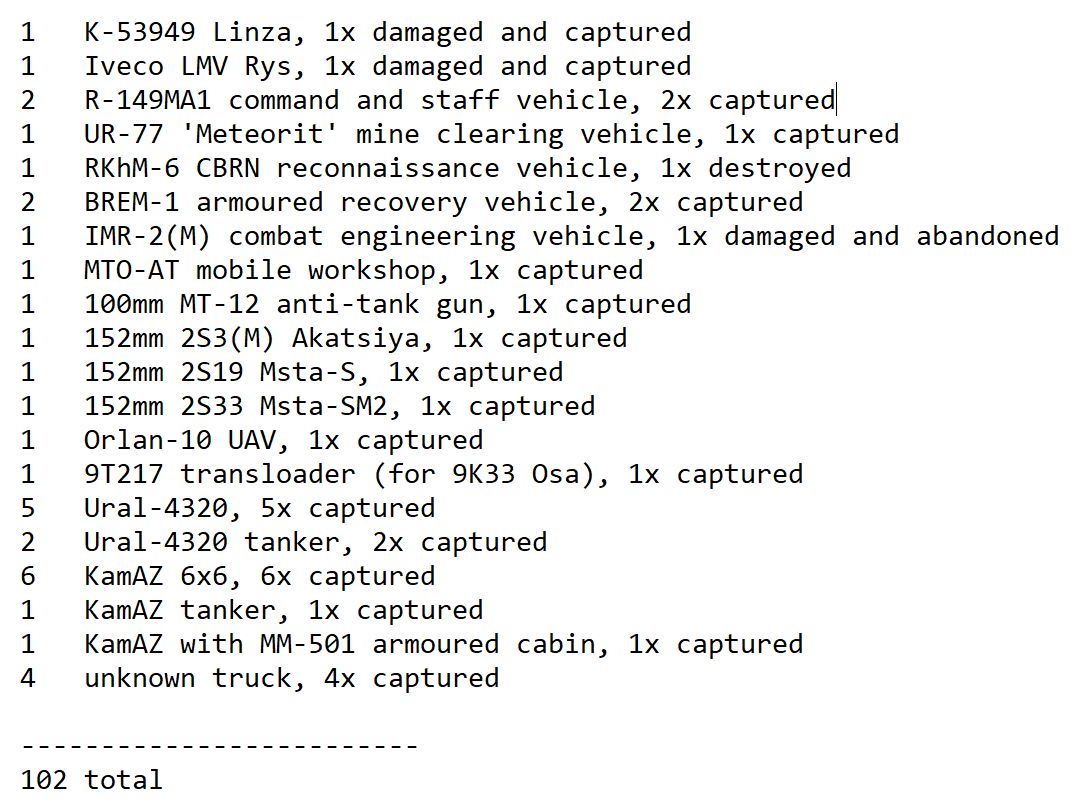
#UkraineWar: Overview of Russian equipment losses added on 12/09/2022
Another insane day - 99 entries!
Full list: oryxspioenkop.com/2022/02/attack…

Another insane day - 99 entries!
Full list: oryxspioenkop.com/2022/02/attack…


#UkraineWar: Overview of Russian equipment losses added on 13/09/2022
Another massive 2-page list!
Full list: oryxspioenkop.com/2022/02/attack…

Another massive 2-page list!
Full list: oryxspioenkop.com/2022/02/attack…
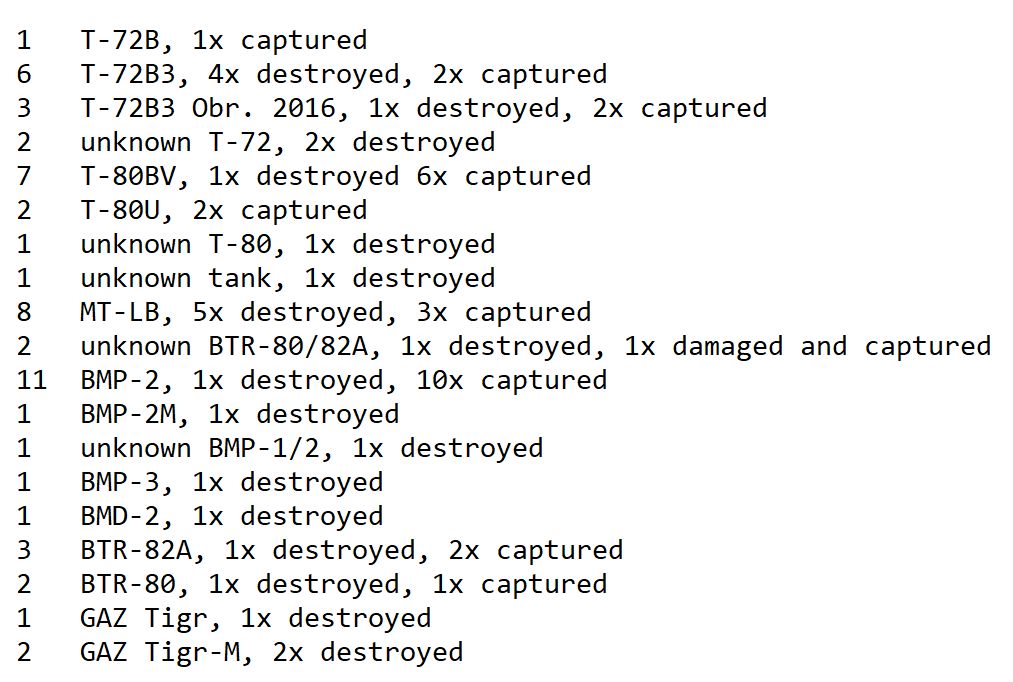

#UkraineWar: Overview of Russian equipment losses added on 14/09/2022
Today's list is only slightly less crazy with 82 entries
Full list: oryxspioenkop.com/2022/02/attack…

Today's list is only slightly less crazy with 82 entries
Full list: oryxspioenkop.com/2022/02/attack…


#UkraineWar: Overview of Russian equipment losses added on 15/09/2022
Full list: oryxspioenkop.com/2022/02/attack…

Full list: oryxspioenkop.com/2022/02/attack…


#UkraineWar: Overview of Russian equipment losses added on 14/09/2022
Full list: oryxspioenkop.com/2022/02/attack…
Full list: oryxspioenkop.com/2022/02/attack…

#UkraineWar: Overview of Russian equipment losses added on 14/09/2022
Full list: oryxspioenkop.com/2022/02/attack…
Full list: oryxspioenkop.com/2022/02/attack…

#UkraineWar: Overview of Russian equipment losses added on 19/07/2023
Full list: https://t.co/2e98CrR9jJoryxspioenkop.com/2022/02/attack…


Full list: https://t.co/2e98CrR9jJoryxspioenkop.com/2022/02/attack…


#UkraineWar: Overview of Russian equipment losses added on 21/07/2023
Full list: https://t.co/GoKU8JTCenoryxspioenkop.com/2022/02/attack…

Full list: https://t.co/GoKU8JTCenoryxspioenkop.com/2022/02/attack…

#UkraineWar: Overview of Russian equipment losses added on 11/12/2024
Full list: oryxspioenkop.com/2022/02/attack…
Full list: oryxspioenkop.com/2022/02/attack…

• • •
Missing some Tweet in this thread? You can try to
force a refresh


